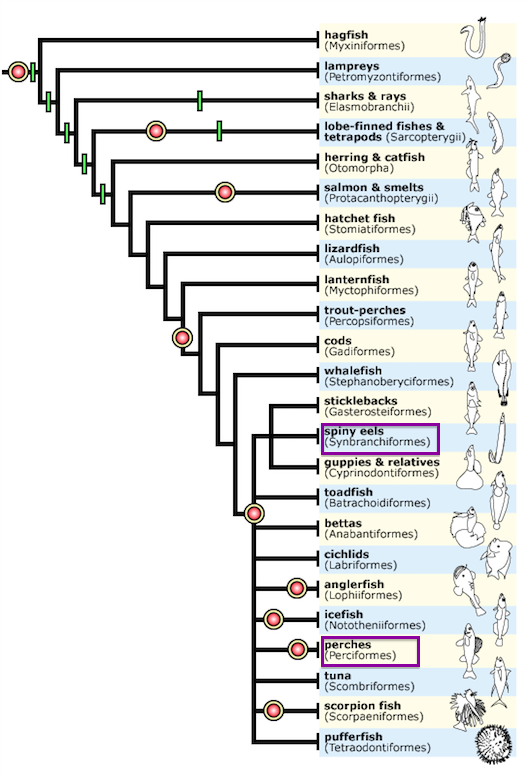Cooperative Hunting Behavior of Moray Eels and Groupers
Biology 342 Fall 2015
Clara Herrera & Hye Min Park
Phylogeny
When we look at phylogeny of an organism, we ask:
1) Which ancestors in the phylogenetic tree first possessed the trait and how does this correlate with speciation?
2) Which selective pressures have shaped this behavior?

Figure 3. Phylogenetic tree showing the evolutionary relation between giant moray eels (Synbranchiformes category) and groupers (Perciformes category).
Phylogeny of Cooperative Hunting
For cooperative hunting to occur, different species must evolve different and complementary hunting roles, meaning that some individuals benefit more than others. Referential gestures have evolved in different taxa, suggesting an ecological advantage for this behavior. In the case of giant moray eel and grouper cooperative hunting, each fish has a specific hunting strategy (morays hunt in crevices and groupers hunt in open water) that allows for a mutually beneficial behavior. However, the evolution of specialized roles in the case of cooperative hunting may often be discouraged by the hierarchy that this creates which allows some individuals to benefit more than others while putting distributing greater risk to other individuals. Furthermore, the phylogeny of cognitive abilities have been studied in using different approaches in recent years with the advent of new genetic techniques that allow us to compare conserved genes across several different species (O'Connell and Hofmann 2011).
Cooperation in protecting a school of fish from a predator attack has been observed in pairs of sticklebacks (Gasterosteus aculeatus) and guppies (Poecilia reticulata),which will approach the predator in alternating moves. This coordinated behavior may be a result of a "prisoner's dilemma" because if a partner cheats during the cooperation, it will have a greater chance of escaping from the predator at the risk of the other individual's safety, but if both partners cooperate, the chances of survival for the two parties increase simultaneously. Pairs of fish solve this dilemma by using alternating tactics during the team play by mimicking the strategy used by the other individual in the previous round of cooperation. This mimicking strategy is called tit-for-tat. The reasons for this cooperative behavior are not yet clear, but researchers have discovered that fish can develop a preference for a specific partner for this cooperative behavior. In addition, fish develop a "trust" for the partner they cooperated with in the previous round, and show less hesitation when they confront a predator when they are with a familiar partner (Milinski et al. 1990).
We can infer that even though cognitive abilities are used differently by different fish in their respective environments, fish develop appropriate social abilities and strategies that will increase their fitness despite the cost of obtaining that particular behavioral trait through learning. We can also observe conserved genes and molecular processes underlying behavior across different species and their ancestors to analyze the importance of certain behaviors to specific environments. Furthermore, similar patterns in cooperation, where individuals will consistently choose to collaborate with an effective partner, have been observed in fish as well as mammals, suggesting that similar evolutionary pressures shaped this cooperative behavior (Vail et al. 2014).These experiments are further explained in the "Ontogeny" page.